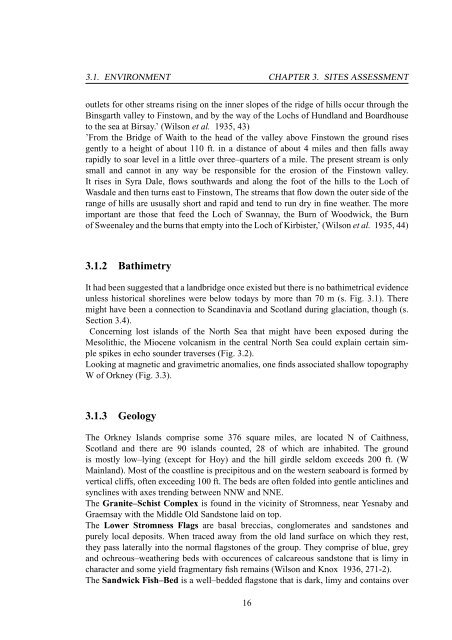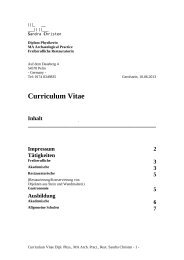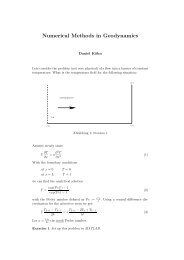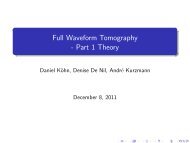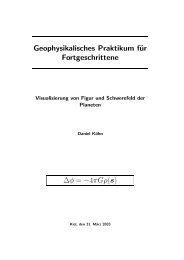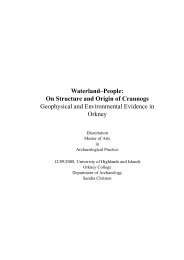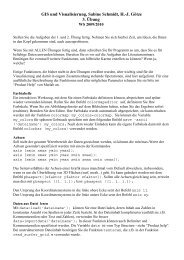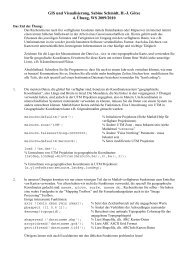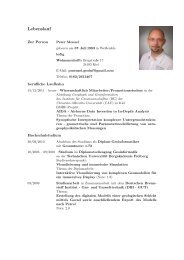Waterland–People: On Structure and Origin of Crannogs ...
Waterland–People: On Structure and Origin of Crannogs ...
Waterland–People: On Structure and Origin of Crannogs ...
Create successful ePaper yourself
Turn your PDF publications into a flip-book with our unique Google optimized e-Paper software.
3.1. ENVIRONMENT CHAPTER 3. SITES ASSESSMENT<br />
outlets for other streams rising on the inner slopes <strong>of</strong> the ridge <strong>of</strong> hills occur through the<br />
Binsgarth valley to Finstown, <strong>and</strong> by the way <strong>of</strong> the Lochs <strong>of</strong> Hundl<strong>and</strong> <strong>and</strong> Boardhouse<br />
to the sea at Birsay.’ (Wilson et al. 1935, 43)<br />
’From the Bridge <strong>of</strong> Waith to the head <strong>of</strong> the valley above Finstown the ground rises<br />
gently to a height <strong>of</strong> about 110 ft. in a distance <strong>of</strong> about 4 miles <strong>and</strong> then falls away<br />
rapidly to soar level in a little over three–quarters <strong>of</strong> a mile. The present stream is only<br />
small <strong>and</strong> cannot in any way be responsible for the erosion <strong>of</strong> the Finstown valley.<br />
It rises in Syra Dale, flows southwards <strong>and</strong> along the foot <strong>of</strong> the hills to the Loch <strong>of</strong><br />
Wasdale <strong>and</strong> then turns east to Finstown, The streams that flow down the outer side <strong>of</strong> the<br />
range <strong>of</strong> hills are ususally short <strong>and</strong> rapid <strong>and</strong> tend to run dry in fine weather. The more<br />
important are those that feed the Loch <strong>of</strong> Swannay, the Burn <strong>of</strong> Woodwick, the Burn<br />
<strong>of</strong> Sweenaley <strong>and</strong> the burns that empty into the Loch <strong>of</strong> Kirbister,’ (Wilson et al. 1935, 44)<br />
3.1.2 Bathimetry<br />
It had been suggested that a l<strong>and</strong>bridge once existed but there is no bathimetrical evidence<br />
unless historical shorelines were below todays by more than 70 m (s. Fig. 3.1). There<br />
might have been a connection to Sc<strong>and</strong>inavia <strong>and</strong> Scotl<strong>and</strong> during glaciation, though (s.<br />
Section 3.4).<br />
Concerning lost isl<strong>and</strong>s <strong>of</strong> the North Sea that might have been exposed during the<br />
Mesolithic, the Miocene volcanism in the central North Sea could explain certain simple<br />
spikes in echo sounder traverses (Fig. 3.2).<br />
Looking at magnetic <strong>and</strong> gravimetric anomalies, one finds associated shallow topography<br />
W <strong>of</strong> Orkney (Fig. 3.3).<br />
3.1.3 Geology<br />
The Orkney Isl<strong>and</strong>s comprise some 376 square miles, are located N <strong>of</strong> Caithness,<br />
Scotl<strong>and</strong> <strong>and</strong> there are 90 isl<strong>and</strong>s counted, 28 <strong>of</strong> which are inhabited. The ground<br />
is mostly low–lying (except for Hoy) <strong>and</strong> the hill girdle seldom exceeds 200 ft. (W<br />
Mainl<strong>and</strong>). Most <strong>of</strong> the coastline is precipitous <strong>and</strong> on the western seaboard is formed by<br />
vertical cliffs, <strong>of</strong>ten exceeding 100 ft. The beds are <strong>of</strong>ten folded into gentle anticlines <strong>and</strong><br />
synclines with axes trending between NNW <strong>and</strong> NNE.<br />
The Granite–Schist Complex is found in the vicinity <strong>of</strong> Stromness, near Yesnaby <strong>and</strong><br />
Graemsay with the Middle Old S<strong>and</strong>stone laid on top.<br />
The Lower Stromness Flags are basal breccias, conglomerates <strong>and</strong> s<strong>and</strong>stones <strong>and</strong><br />
purely local deposits. When traced away from the old l<strong>and</strong> surface on which they rest,<br />
they pass laterally into the normal flagstones <strong>of</strong> the group. They comprise <strong>of</strong> blue, grey<br />
<strong>and</strong> ochreous–weathering beds with occurences <strong>of</strong> calcareous s<strong>and</strong>stone that is limy in<br />
character <strong>and</strong> some yield fragmentary fish remains (Wilson <strong>and</strong> Knox 1936, 271-2).<br />
The S<strong>and</strong>wick Fish–Bed is a well–bedded flagstone that is dark, limy <strong>and</strong> contains over<br />
16


